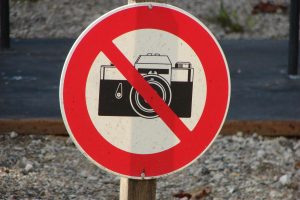Ethical Photography: The Full Picture
While abroad, you will have many opportunities to take photos and capture memories. These moments can be beautiful and help you to remember your time abroad, but we must also remember that while in other countries and cultures we have a responsibility to respect the limits of what we should photograph. This is called ethical photography and is something of which we should always be mindful while abroad.
Things to Consider
Is your photo legal?
Oftentimes, countries have different laws when it comes to allowing the
photography of people in public places. If you are trying to take a picture of a
certain object or a specific person, always be careful to ask whether it is legal or
not.
Did you get permission?
Public Places

When going into any place abroad, you should always look for signs that state if photography is allowed or not. A common sign for this may look like this:
Asking for Permission
If you are going to take a photo with or of someone, you should always ask permission. If you are in a public place and there are people in your shot, but they are not the focus, then this is okay. If you are taking a photo of someone specifically, it is always important to get their permission. Think: how would you feel if someone shoved a camera in your face with no warning?
Be Aware of your Surroundings
Are others taking pictures around you? What are they taking pictures of? Make sure you treat places and people in the same way as those around you (especially pay attention to how locals are behaving – they will usually know more than you do).
Are your photos contextualized?
The Whole Image
While it is easy to take photos, the way others see these photos can be much more difficult to control. You must be careful to show people a whole image and not just the part you want them to see. Make sure that your photos are not exploiting the poor’s condition in order to generate likes on Instagram, nor that they are being used to capture only a one-dimensional version of people who live in other countries or in poverty.
The Whole Story
Did you learn the story of the person whom you are photographing? Oftentimes when in different cultures we can make assumptions that are not correct, but they may seem accurate because of our race, culture, gender, etc.
 For example, what do you think is happening in this photo? What assumptions do you make about the people in this picture? About the event?
For example, what do you think is happening in this photo? What assumptions do you make about the people in this picture? About the event?
Talk to people and get their stories before you post photos of them. If you don’t know the person you took a photo of and are just assuming their story, you probably should avoid posting it, for the sake of not spreading more misinformation.